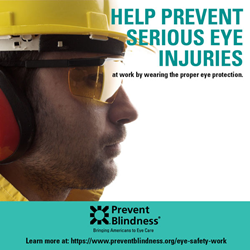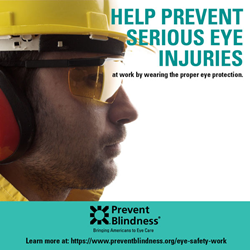
For “Workplace Eye Wellness Month” in March, Prevent Blindness provides free resources to help save sight
“Recognizing your eye health and safety needs within the workplace, and taking all the necessary steps to protect vision, can help us all to continue to protect healthy eyesight for years to come,” said Jeff Todd, president and CEO of Prevent Blindness.
CHICAGO (PRWEB)
February 27, 2020
Prevent Blindness, the nation’s oldest eye health and safety nonprofit organization, has declared March as Workplace Eye Wellness Month. According to the Centers for Disease Control and Prevention (CDC), approximately 2000 U.S. workers sustain a job-related eye injury that requires medical treatment a day. About one third of the injuries are treated in hospital emergency departments, and more than 100 of these injuries result in one or more days away from work.
For those who work outside an office setting, Prevent Blindness warns of common causes for eye injuries and urges everyone to wear the proper eye protection for risks that include:
- Flying objects (bits of metal, glass)
- Tools
- Particles
- Chemicals
- Harmful radiation
- Any combination of these or other hazards
The type of safety eye protection that Prevent Blindness recommends depends on the hazards in the workplace. For areas that have particles, flying objects, or dust, safety glasses with side protection (side shields) should be worn. Goggles should be worn for anyone working with chemicals. And, for those working near hazardous radiation (welding, lasers, or fiber optics) special-purpose safety glasses, goggles, face shields, or helmets designed for that task should be worn.
Those who work within an office setting (working with computers and other digital devices) are at higher risk for digital eye strain. According to the American Academy of Ophthalmology (AAO), eye strain symptoms include dry eyes, blurry vision, tearing or watery eyes, and headache. The cause of digital eye strain is that people blink less when they stare at digital devices. The AAO adds that normally, humans blink around 15 times per minute—but this “blink rate” can be cut in half when staring at screens or doing other near work activities (like reading).
Prevent Blindness recommends placing a digital screen 20 to 26 inches away from the eyes and slightly below eye level. Also, adjust lighting to lower glare and harsh reflections. More tips may be found at: https://www.preventblindness.org/computers-and-your-eyes.
“Recognizing your eye health and safety needs within the workplace, and taking all the necessary steps to protect vision, can help us all to continue to protect healthy eyesight for years to come,” said Jeff Todd, president and CEO of Prevent Blindness.
For more information about workplace eye health topics, please call Prevent Blindness at (800) 331-2020 or visit https://www.preventblindness.org/eye-safety-work.
About Prevent Blindness
Founded in 1908, Prevent Blindness is the nation’s leading volunteer eye health and safety organization dedicated to fighting blindness and saving sight. Focused on promoting a continuum of vision care, Prevent Blindness touches the lives of millions of people each year through public and professional education, advocacy, certified vision screening and training, community and patient service programs and research. These services are made possible through the generous support of the American public. Together with a network of affiliates, Prevent Blindness is committed to eliminating preventable blindness in America. For more information, or to make a contribution to the sight-saving fund, call 1-800-331-2020. Or, visit us on the Web at preventblindness.org or facebook.com/preventblindness.
Share article on social media or email:

